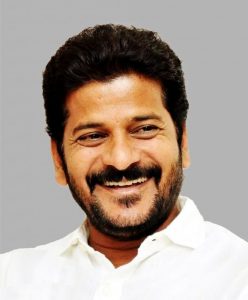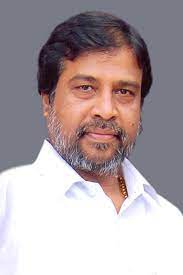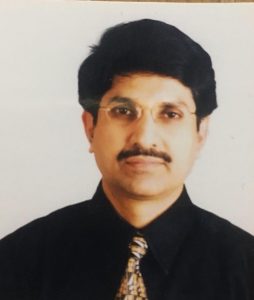=
Sri A. Revanth Reddy
Chief Minister of Telangana
Sri Damodar Rajanarasimha
Minister of Health, Medical & Family Welfare Minister, Government of Telangana
Smt. Christina Z.Chongthu, IAS
Health secretary
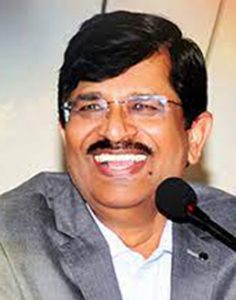
B. Karunakar Reddy
Vice chancellor
Dr Bandi Triveni
DME- Director of Medical Education
Dr Narendra Kumar Are
MBBS, M.S(Gen.Surg), Mch (Ped.Surg)
Additional Director of Medical Education (ADME)
Principal – Osmania Medical College
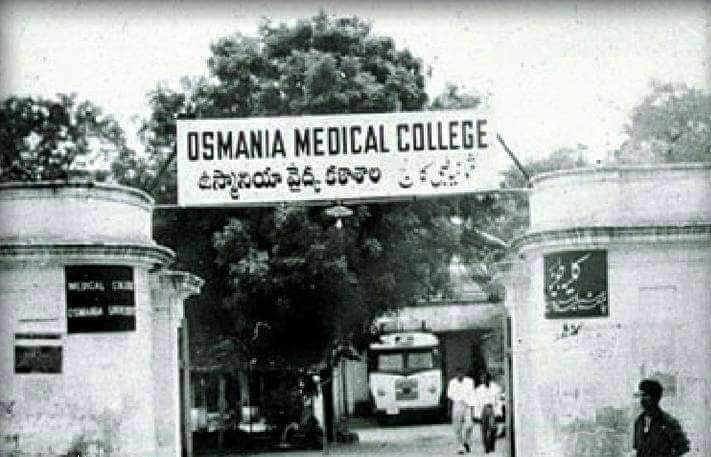
The Hyderabad Medical School which came into existence in 1846 A.D. was the fore-runner of Osmania Medical College. The medium of instruction was Urdu ,the degree was Hakeem. Last two decades of nineteenth century was the glorious period of this school. Seventh and the last Nizam of Hyderabad Nawab Mir Osman Ali Khan established Osmania University in 1919 A.D. and in the following year the Hyderabad Medical College. In 1957 A.D. Hyderabad became the Capital of enlarged Andhra Pradesh. Tremendous zeal and enthusiasm was evident to achieve all round progress in medical education.
Medical Education, Research and health care of the people are vastly improved by the presence of medical college and teaching hospital in any area and in an atmosphere of medical research. This is true of Hyderabad also.
Darush-Shifa
The actual origin of medical education in Hyderabad dates back as far as 1595, when Mohammad Quli Qutub Shah, the 5th King of Gloconda had founded a general hospital _‘Darush-Shifa’ (House of cure) together with an attached medical school, where the Unani system of medicine was taught and practiced. The building can be seen even today on the southern bank of river Musi, behind the building of Salarjung Museum.
A Medical School at Bolarum
A medical school was started at Bolarum in about 1836 or 1839 by Assistant Surgeon Thomas Key and Simon Young, the staff Surgeon of the Hyderabad Contingent, for training of natives of Deccan, as medical subordinates for service in the Hyderabad contingent. According to the records of the Nizams’s Army, Surgeon Key was in 1840, Medical Store Keeper and Superindent of the Medical School at Bolarum. This school was closed from 1st May, 1846.
This measure was severely criticised in the local press. The resident explained that, he abolished the Bolarum school, merely to establish another, with wider aims. Thus, the Resident obtained the sanction of the Nizam to establish a medical school at the Residency, for teaching European Medicine to native youths of Deccan, through the medium of Urdu. Dr. Maclean was appointed Superintendent and teacher of the school with handsome extra allowance of five hundred rupees per month as his special pay for this work. He took a house of Mr. Ogilvie based on monthly rent of Rs.30/- at Gunfoundry, engaged a clerk Mir Ameer Ali, a translator Mr. Murrey and two peons. This was the first successful vernacular medium medical school, established in India in the early part of the year 1846. The school was shifted later to the new premises in the compound of Residency Hospital and it was enlarged in 1848 to provide for wider opportunity in clinical instructions. Manuscript records pertaining to this event are preserved in National Archives, Delhi, extract of which is as under :
“It is proposed that the school shall be held in a house which Dr. Maclean has hired for this purpose from Mr. Ogilvie, situated about three quarter of a mile from the residency on the public road to Secunderabad and the young man who feel disposed to attend may do so at 10 O’clock on the 1st proximo, when Dr. Maclean will be in readiness to receive them”
The story behind the opening of the Hyderabad Medical School is that, the Fourth Nizam of Hyderabad Nawab Nasir-ud-Dawlah fell ill (probably he was suffering with Diabetes) in 1842 / 43 A.D. and he did not recover for quite sometime under the treatment of Unani Hakeems, as all the people in Hyderabad had belief in Unani Medicine and no one practiced Allopathic Medicine here before 1846 A.D.
Mr.Fraser the then British Resident in Hyderabad recommended treatment of the ailing Nizam by the residency surgeon Dr. William Campbell Maclean. He treated the Nizam by adjustment in his daily diet, without any medicine, as the Nizam wanted that, he must be cured without having to eat or drink any Allopathic Drug. The King followed the diet schedule as prescribed by Dr. Maclean and recovered within a period of three months. The western system of medicine, thus appears to have gone high in his estimate and so, he ordered for the establishment of the medical school in Hyderabad.
But, for one year no student came forward. The matter was reported to the Nizam, then as per his order ten candidates were sent to the school by Shamsul Umra Bahadur on Monday, 27th Ramadan, 1262 A.H (1847 A.D.)
The students of the first batch trained by Dr. Maclean appeared in 1852-53, for a final examination by a committee of three medical officers. The standard adopted was a high one. Following ten were declared qualified and received official diplomas from the institute:
1. Mohammed Ashraf
2. Henry Peacock
3. Mohammad Baquer Ali
4. Faizullah Khan
5. Syed Omer
6. Ain Khan
7. Ghulam Jeelani
8. Khawja Ashraf
9. Mohammad Yakoob
10. Peer Khan
In 1854, the following seven candidates were declared qualified :
1. Lutf-e-Ali
2. Mirza Ali
3. Mohammad Maulana Sahab
4. Mohammad Vazir Ali
5. Shamsuddin
6. Faqueer Sahab
7. Mohammad Raza
These well trained medical men were employed as Taluka Surgeons with a salary of Rs.30/- per month. Some of them established themselves as private practitioners in the city.3
It was a successful venture and much of the success was due to Dr. Maclean’s personality, who excelled as a teacher and lecturer. He threw his heart in the development of the school. He had to teach, translate, encourage, conciliate. Besides this there were no textbooks, more over the preliminary education acquired by the lads, not a kind to give a teacher very elevated platform of general knowledge, on which to raise the structure of medical sciences.
A greatest object kept steadily in view by Dr. Maclean, consisted in impressing upon his pupils a sense of the high and honorable character of the medical profession, and in endeavoring to induce them to act always upon principles of rectitude and honesty. He endeavoring to raise their moral tone to as high a level as he could, and he inculcated the values of manly, honest and truthful conduct in all their intercourse, whether professional or private, with those around them. When this man of integrity, character and intellect left Hyderabad for England due to his ill health, his old student literally fell upon his neck, clung to him weeping bitterly.
Assistant Surgeon Dr. George Smith succeeded Dr. Maclean in December 1854 and started session on 5th February 1855 A.D. to the junior batch of students who had been in the school for a short time. Fresh batch of students admitted. He followed the printed syllabus, but subjects of physiology and chemistry were added in the syllabus. He himself taught Anatomy, physiology, surgery, theoretical and practical medicine and midwifery , disease of the eye, operative surgery, while Mr. Murrey instructed in Materia Medica, Bandaging and in testing for poisons. The entire course and syllabus was mastered in four sessions. Dr. Smith followed the footsteps of Dr. Maclean and raised the reputation of the school by training a large number of very able and successful Hakeems (Doctors). The school was conducted in the rooms of the Residency Hospital opposite to Residency Surgeon’s house.
Risala-e-Tibabat (Hyderabad Medical Journal)
For keeping up a connection between the school and the passed Hakeems (Doctors) and for stimulating them for study and observation, led to the publication of a Medical Journal in Urdu., which was started by Dr. Smith in 1855. Copies of the Hyderabad Medical Journal were regularly sent to each Hakeem (Doctor) and given to each student, while 50 copies of each issue were forwarded to the Governments of Calcutta, Madras and Agra and 20 to the Government of Bombay. The issue was numbering 300 copies of which, the expenses of 100 copies were borne by the Prime Minister Nawab Salarjung Bahadur who also granted the use of his Lithographic press and that of the remaining 200 copies was defrayed by the subscriptions of the respective Governments as named above. The young Hakeems (Doctors) were encouraged to contribute articles
.Sometime in 1861, Dr. Smith left Hyderabad and Dr. Fleming took charge as residency surgeon, and Superintendent of the school. Dr. Johnson was appointed as the second teacher of the Medical School and assistant to Dr. Fleming. During Dr. Fleming’s time 33 students got admission into the school. But many students discontinued of their own will or were expelled due to poor progress in the class. Encouragement was given to the study of English by awarding stipened of Rs.4/- per month, to students who were educated in English, in the school of Darul-Uloom, before admission into the Medical School. In 1862, another examination was held by a committee, of which the Chairman was Dr. Forbes, General doctor of Secunderabad and the members were Dr. Sanderson, of Alwal and Dr. Martin of Secunderabad.
It was about this time that Sir Salarjung thought of establishing a hospital in the city, for the benefit of the sick, poor, the wounded and also to afford better facilities to medical students to acquire wide experience of patients and diseases. Though the school has been in existence for about two decades, it was not on a sound footing as there was no regular medical service, to absorb the students passing the qualifying examinations. So in 1886, Sir Salarjung created a Medical Department and put it under the control of an officer, who at the same time occupied the post of the superintendent of the medical school. The cadre and pay of medical service was also established on regular system and the districts. There were seven Government physicians in the city.
Afzalgunj Hospital
Sir Salarjung —I, Nawab Turab Ali Khan Mukhtar-il-Mulk Bahadur established a public hospital on the northern bank of river Musi. When this was planned, built and occupied in 1866, it was named after the then ruler Afzal-ud-Daulah and came to be known as Afzalgunj Hospital. It was Dr. Fleming, who labored hard to plan and build this hospital according to the wishes and orders of the Sir Salarjung. It was also teaching hospital, in addition to already existing British Residency Hospital (Presently Sultan Bazar Hospital).
First Salarjung the Minister took great interest in the institution. Much of the success of the medical school was due to the sustained personal interest taken in it by him and much also to the thoughtful and earnest advice of successive superintendent, especially Dr. Maclean and Dr. George Smith. Salarjung took the initiative for the provision of medicine and instruments in the medical school. He instituted awards for special merit and sanctioned the bi-monthly issue of medical periodical.
In 1866/67, Dr. Fleming was succeeded by Dr. Pamberton whose promising career was cut short soon after he took charge of the new hospital at Afzalgunj, and started to give excellent training to the staff and the students. Dr. Mohammad Vazir was appointed as Resident surgeon of Afzalgunj Hospital. Dr. Wyndowe, who succeeded Dr. Pamberton as Resident Surgeon and Superintendent of the school and hospital in 1867, was in that post for 15 years and effected some improvement in the hospital and the school. During Dr. Wyndowe’s absence on furlough on two occasions, Dr. Lawrie acted as superintendent of the medical school and chief of the hospital. Dr. T. Beamount, who came after Dr. Wyndowe in 1881/82 left the station on furlough after three years, and was succeeded by Dr. Edward Lawrie in 1884/85 as Residency surgeon who put Hyderabad on the medical map. He worked with a rare spirit of service to the poor patients in the hospital for whose benefit he later endowed a fund, out of which milk and other articles of food were supplied to the needy patients. It was during his time many momentous changes occurred in the school, English was adopted as the medium of instruction in place of Urdu.
The old Board of Examination from Secunderabad was replaced by the Board of Examiners of Madras Medical College, 1889-90. The staff was augmented and the school commenced training for the following three grades of Medical Personnel.
1. Hakeems with a course of 7 years corresponding to the superior grade
2. Dressers with a course of 5 years forming a lower grade
3. Berar pupils intended for service in the military department of Berar under the resident.
Hyderabad Chloroform Commission
Dr. Lawrie attained international fame on account of his letters, articles and reports in British Journals with regard to the controversy relating to the methods and dangers of Chloroform administration, and describing his experiments upon dogs on the proper administration of chloroform. On his application the Nizam’s Government appointed the first commission in 1888 consisting of Surgeons P. Hehir as president, Mr. J.A. Kelly and Mr. A. Chamarette, as members.
As a result of experiments the commission came to the conclusion _‘that chloroform may be given to dogs by inhalation with perfect safety, and without any fear of accidental death, if only the respiration, and nothing but the respiration, is carefully attended to through out’. The report of the commission was adversely criticized by the leading Medical Journals, but Lawrie’s faith in the correctness of his master, Syme’s teaching that chloroform can be used judiciously so as to do good without the risk of evil, and the importance of the cause he upheld was so great that at his request the Nizam’s Government made an offer to the ‘Lancet’ to meet all expenses for having the work repeated and invited that journal to send a scientist of high standing whose opinion would be accepted by the medical profession generally.
The offer was accepted and the second commission (usually referred to as the Hyderabad Chloroform Commission) was constituted as follows in 1889.
Surgeon Major E. Lawrie, President
Dr. T. Lauder Brunton, Member (from _‘Lancet’)
Surgeon Major Gerald Bomford, Member
Dr. Rustomji, Member.
The members of the first commission were also associated with the second commission. A very large number of experiments were performed on various species of animals under a variety of conditions.
The report of this commission appeared in the Lancet of January 18, 1890, and the final report of the Chloroform Commission was printed in 1891.
Dr. Lawrie visited to Britain also with two of his students from Hyderabad Medical School to demonstrate to the British medical scientists in England. The safer method of administration, called _‘Hyderabad Chloroform Technique’ practiced by him at Hyderabad, by _‘Hyderabad Chloroform Cap’. The demonstration took place on 25th May, 1894 A.D. The student who actually administrated anesthesia was Dr. (Hakeem) Mohammad Abdul Ghani. The surgeon who performed an appendectomy and Nephrectomy operation was Dr. (Later Sir) Fredrick Treve, the head of the department of surgery, and he was satisfied by the conduct of the anesthesia. This enhanced the prestige of the medical school at Hyderabad and put it on the medical map.
On the other hand, the discovery of the life cycle of Malaria parasite by Ronald Ross also took place at Hyderabad in 1897. All these achievements made medical profession of Hyderabad known to all the medical world for its enquiring mind and research.
It will thus be seen that, not with standing the interest shown by the state in the school, and the great inducements held out to the students in the shape of stipends, prizes and appointments, the early history of the institution was rather a checkered one, with the lapse of time and the influence of qualified men turned out by the school, the prejudice against the Western System of Medicine became less marked while the introduction of English as the medium of instruction rendered the teaching more direct and therefore more interesting with the result that the number of students began to steadily increase.
By the end of the 19th century, the Hyderabad Medical School, had developed into a very illustrious institution, with adequate staff and eminent teachers. The school was then training natives of the state for service as Hakeems in the Nizam’s dominion and hospital hospital assistants in Barer service. Examination for the diploma was held by special arrangements with the Board of the Madras medical college and the standard was the same as that of the L.M & S., Degree of the Madras University. In the last decade of 19th century, Women’s (Zenana) section under the supervision of a lady doctor was also opened in Afzalgunj hospital and admission was given to women students also to study medicine, and especially midwifery.
The old classification of categories of students of the school
1. Hakeems
2. Hakeems (Female)
3. Hakeems (Private)
4. Hakeems (Female Private)
5. Dressers
6. Barar pupils and
7. Private pupils, was changed into following more acceptable terms :
- 1. Assistant Surgeons Class
- 2. Hospital Assistant Class
- 3. Sub-Assistant Surgeons Class
By 1898, there were 100 students of various categories. As there was a Plague epidemic in the state, several students were put on plague duty and therefore there was no official examination in 1898.
Alterations and additions were made to the buildings of the school in the residency (Sultan Bazar) Hospital providing for lecture halls, chemical laboratories and anatomy dissection hall and pathology lab and postmortem room. There were improvements in the curriculum and new addition to the staff.
Scholarships were specially provided to encourage women students to take up study of medicine. The school had produced more than 100 male doctors called Hakeems and a few women doctors by the end of the century, who served in the hospitals and civil dispensaries in the city and in the districts and other parts of state and also took part in the fight against the epidemic of Cholera, Plague and Smallpox all over the state.
Dr. Lawrie retired in May 1901 after a long and glorious record as a Residency Surgeon, as Director of Medical Deparment of Nizam, and as Superintendent of the Hyderabad Medical School. Dr. Gimlette took charge of the school as principal and lecturer in surgery and ophthalmology in 1901. As principal he complained that students were reluctant to join the school. Few young men of good social standing were attached to the school as there were only limited number of appointments. The most urgent necessity of the school was affiliation to a university because if a university degree was awarded, a large number of students may be coming forward to join the school. Some improvements were made to the pathological laboratory which was fitted with appliances. The hospital staff began to send pathological specimens for examination and report. There were also changes in the examination Board. The examinations were conducted by the Bombay Medical Board, instead of by Madras Medical Board.


